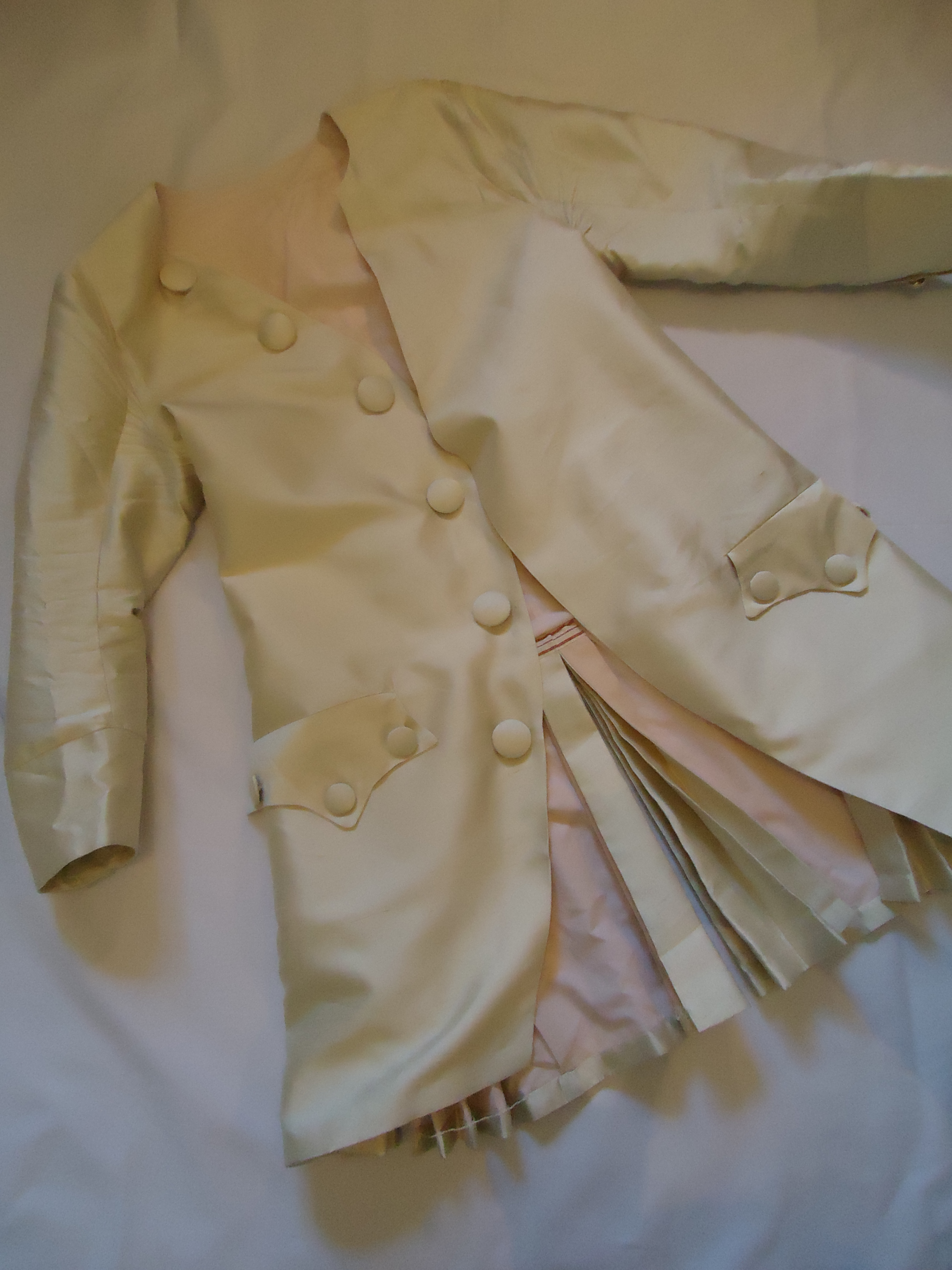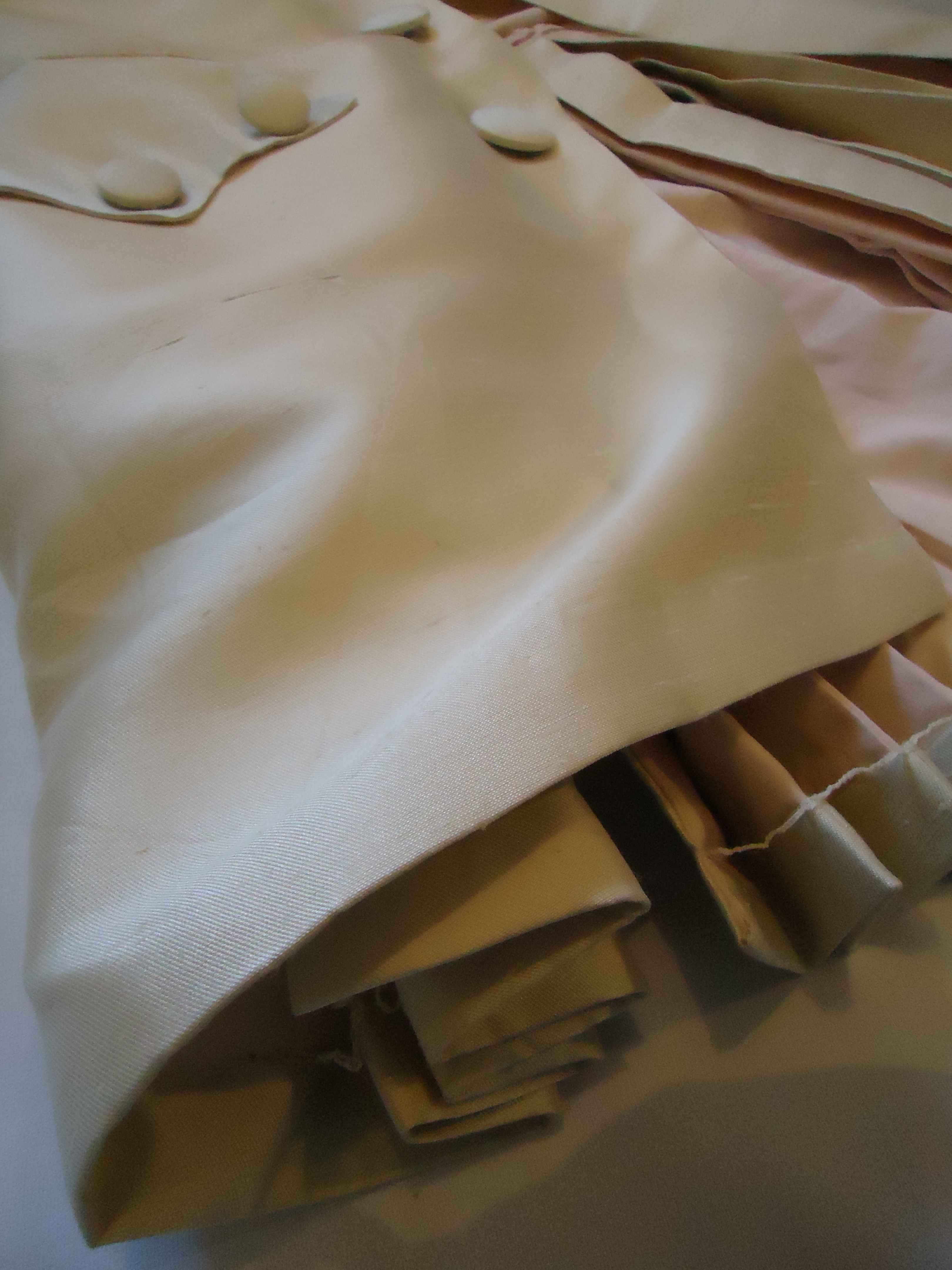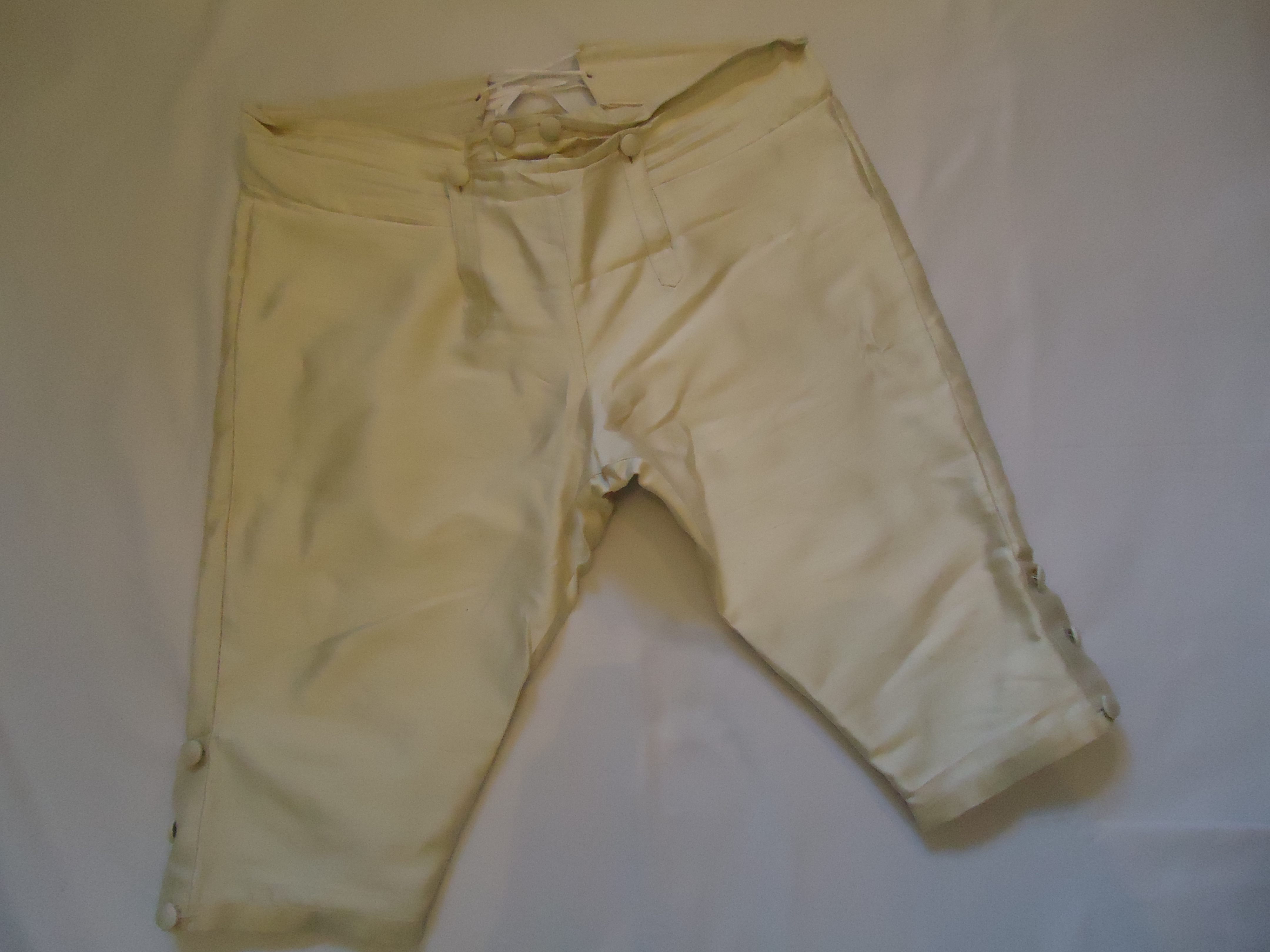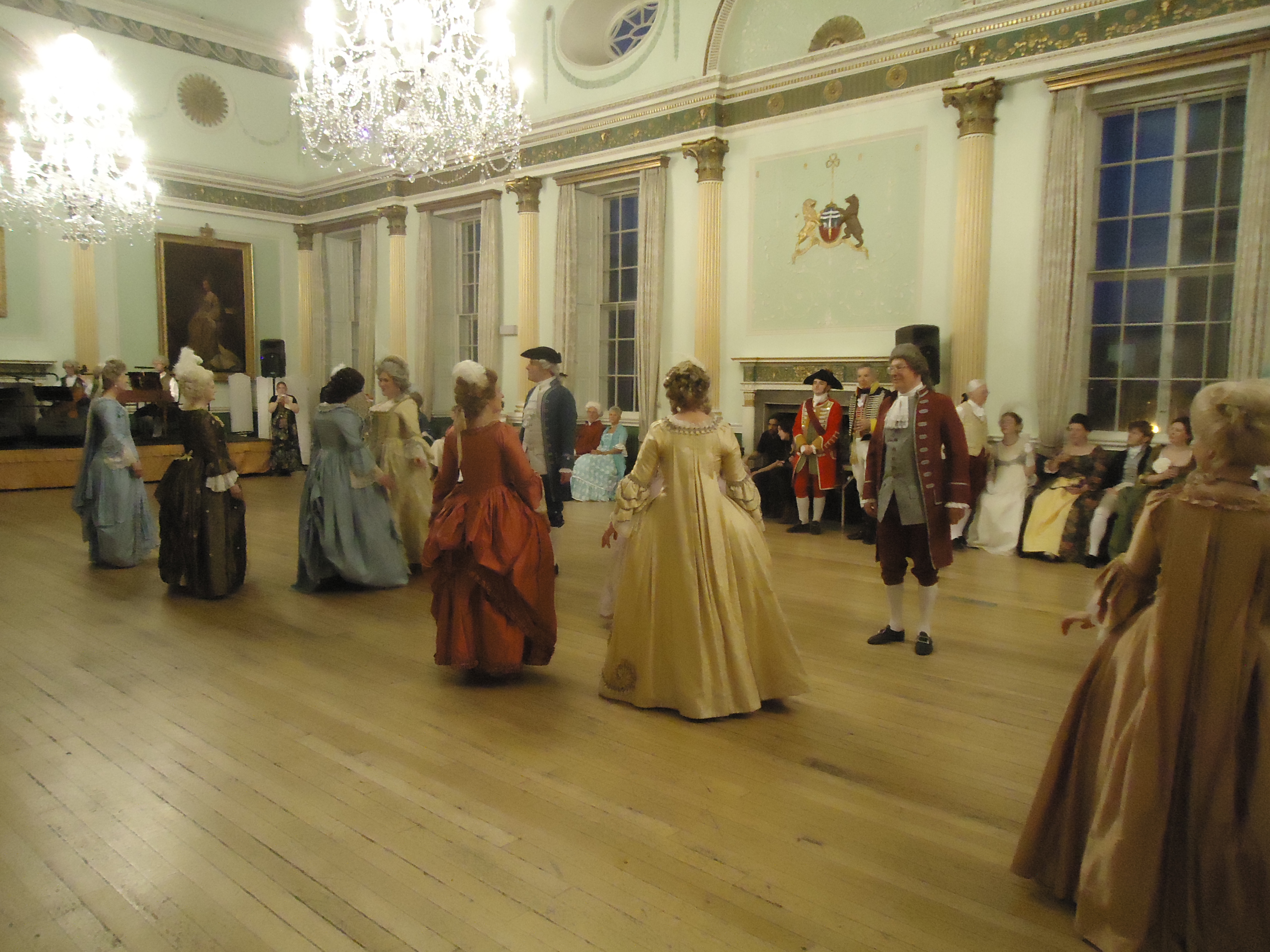Mr Peacock's Outfit of Ivory Dupion:
(The photo is also a Video Link - please click on it)
With the arrival of the last two tickets to the Grand Georgian Ball at the Guildhall in Bath, a sudden order was put in for a 
gentleman's eighteenth century suit of clothes. With only 2 weeks til the deadline, an old curtain was provided for the waistcoat (which actually looked pretty good in the end), measurements were provided promptly and a rather rushed session of Pattern Cutting was begun. Mr Peacock required a 3 piece suit with full length waistcoat and matching coat and breeches and had chosen a really nice solid-weight Dupion in Ivory.

gentleman's eighteenth century suit of clothes. With only 2 weeks til the deadline, an old curtain was provided for the waistcoat (which actually looked pretty good in the end), measurements were provided promptly and a rather rushed session of Pattern Cutting was begun. Mr Peacock required a 3 piece suit with full length waistcoat and matching coat and breeches and had chosen a really nice solid-weight Dupion in Ivory.
- The breeches were designed to be just below the knee based around the period of about 1760's - 70's and where they were getting slightly more streamlined and slim. They were small split falls with traditional plackets and fastened with a pair of covered buttons. the guards were left loose although historically
 they could also be laced for a neater finished.
they could also be laced for a neater finished.
 they could also be laced for a neater finished.
they could also be laced for a neater finished.
- The breeches also had a double-breasted waistband if such a term can be used for a waistband, containing 6 buttons and all covered in self fabric. The breeches also had a lace-up section at the CB and the bands about the knee were also decorated with a shaped placket that matched the jacket. This placket was decorated with 3 cover buttons and only the bottom one, that sat on the leg band was functional.
- The waistcoat was designed to be long waisted and angled at the bottom point. The pocket flaps were cut to the same pattern as the coats though were smaller in size and covered a fully functional pocket. The front of the w/c was run with buttons amounting to 10 and were fully functional - the button holes however, were not up to our best as they were just done on the domestic embroidery machine and lacked 'oomph' as it were. The fronts of the w/c were cut following historic techniques, to spread round to the back of the armhole. Where the fronts and the lining met at the hem, we left a deep slit, again echoing original garments, and created the ends of the fronts into a sharp point so that it sat out over the lining and had a freedom to swing slightly. We double layered the fronts of the w/c to give it a more meatier feel and it had a lovely heaviness about it when we'd done.
were not up to our best as they were just done on the domestic embroidery machine and lacked 'oomph' as it were. The fronts of the w/c were cut following historic techniques, to spread round to the back of the armhole. Where the fronts and the lining met at the hem, we left a deep slit, again echoing original garments, and created the ends of the fronts into a sharp point so that it sat out over the lining and had a freedom to swing slightly. We double layered the fronts of the w/c to give it a more meatier feel and it had a lovely heaviness about it when we'd done.
 were not up to our best as they were just done on the domestic embroidery machine and lacked 'oomph' as it were. The fronts of the w/c were cut following historic techniques, to spread round to the back of the armhole. Where the fronts and the lining met at the hem, we left a deep slit, again echoing original garments, and created the ends of the fronts into a sharp point so that it sat out over the lining and had a freedom to swing slightly. We double layered the fronts of the w/c to give it a more meatier feel and it had a lovely heaviness about it when we'd done.
were not up to our best as they were just done on the domestic embroidery machine and lacked 'oomph' as it were. The fronts of the w/c were cut following historic techniques, to spread round to the back of the armhole. Where the fronts and the lining met at the hem, we left a deep slit, again echoing original garments, and created the ends of the fronts into a sharp point so that it sat out over the lining and had a freedom to swing slightly. We double layered the fronts of the w/c to give it a more meatier feel and it had a lovely heaviness about it when we'd done.
- The coat was collar-less and slim cuffed with decorative placket that matched the breeches knee placket and lined with link cotton and striped sleeve satin lining. The pocket flaps were to be
 used as part of the design feature and were shaped similar to the plackets and decorated with covered buttons. The pockets were fully functional except the buttons. Large covered buttons also decorated the front of the coat but Mr
used as part of the design feature and were shaped similar to the plackets and decorated with covered buttons. The pockets were fully functional except the buttons. Large covered buttons also decorated the front of the coat but Mr
Peacock opted for not having button holes due to expense and time.
 used as part of the design feature and were shaped similar to the plackets and decorated with covered buttons. The pockets were fully functional except the buttons. Large covered buttons also decorated the front of the coat but Mr
used as part of the design feature and were shaped similar to the plackets and decorated with covered buttons. The pockets were fully functional except the buttons. Large covered buttons also decorated the front of the coat but Mr Peacock opted for not having button holes due to expense and time.
- The Coat was also to have fully lined and fully functional coat pleats, both at the CB seam (pleats on either side) and the Side Back Seam (again with pleats either side of this seam). This amounted to 3 sets of pleats with 2 groups of pleats to each
set. Each group of pleats had 4 pleats with the final pleat turning back towards the inside of the coat. As the coat was fully lined so then were these pleats and they hung beautifully. As is necessary with such pleats, a chain stitch was formed to control the pleats. This thread join was only visible from the inside.
the inside of the coat. As the coat was fully lined so then were these pleats and they hung beautifully. As is necessary with such pleats, a chain stitch was formed to control the pleats. This thread join was only visible from the inside.
set. Each group of pleats had 4 pleats with the final pleat turning back towards
 the inside of the coat. As the coat was fully lined so then were these pleats and they hung beautifully. As is necessary with such pleats, a chain stitch was formed to control the pleats. This thread join was only visible from the inside.
the inside of the coat. As the coat was fully lined so then were these pleats and they hung beautifully. As is necessary with such pleats, a chain stitch was formed to control the pleats. This thread join was only visible from the inside.
Here are some photos from the actual event:
The Grand Georgian Ball!
And another...




No comments:
Post a Comment